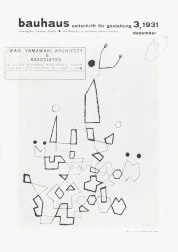bauhaus journal 3
December 1931
ed: bauhaus dessau w. kandinsky
in paul klee, the bauhaus loses an important artist, an outstanding teacher and the most irreplaceable, a great personality, and we all lose a true friend.
mies van der rohe
Source monoskop.org
this issue of the bauhaus journal is dedicated to paul klee.
the reason is klee's departure from the bauhaus. i would prefer to take over my bauhaus colleagues' commission to edit this number for an opposite reason - not departure, but return.
for a full ten years, the work at the bauhaus was closely linked to klee's work at our institute. such connections do not break painlessly.
all members of the bauhaus - teachers and students, especially those who took part in klee's classes - feel this intensively.
i know that it was not easy for klee himself.
as far as i am concerned, i allow myself to express something subjective.
more than 20 years ago i moved to ainmillerstrasse in munich and soon learned that the young painter, who had just made his first successful debut in the thannhauser gallery, paul klee, lived next door to me, almost house to house. we stayed neighbours until the outbreak of the war and that was the beginning of our friendship. the war blew us apart. it wasn't until eight years later that fate led me to the bauhaus in weimar and so we - klee and i - became neighbours for the second time: our studios in the bauhaus were almost next to each other. another blast soon: the bauhaus flew out of weimar at a speed that a zeppelin could envy it for. klee and i owe this flight the third and closest neighbourhood: we live close together for over five years. only a firewall separates our apartments, but we can visit each other despite the wall and without leaving the house - a short walk through the cellar. bavaria - thuringia - stop. what next? but even without a cellar walk, the spiritual neighbourhood remains.
for klee, the bauhaus has already become a memory. but he won’t forget it that soon. klee witnessed and shared the fate of this much-tested institute almost from the very beginning: the initial “heroic” times when young people almost always loved the style of a “wandervogel” - long hair, which became shorter and shorter after just a few days, a bare-chested, which soon got a tie, sandals, which later even turned into patent-leather shoes.
this was only the outer and temporary side of the bauhausler. inwardly, he was already a young man at that time who sought to work with perseverance and seriousness on the design of the new system, studied seriously and worshipped the creative idea. if klee did not have a direct effect on shortening the hair, then his word and his deed, his own example, developed the inner positive sides of the student to a great extent.
the word alone is weak if it is not supported by the energetic, obvious example. by the example of complete devotion to his work, we can all learn from klee. and have certainly learned.
thus not only the purely artistic, but also the purely human qualities come to the fore. the latter are not so conspicuous and their influence not so easy to notice. however, my pedagogical experience teaches me that young people (although often unconsciously) are no less interested in the human qualities of the teacher than in his other qualities - the artistic, scientific, etc. - and that they are not as interested in the human qualities of the teacher as they are in his other qualities.
every knowledge without human basis remains on the surface: the quantity (accumulation of knowledge) grows, but the quality (the fertilizing power of knowledge) remains unchanged. the growth of the outer quantum sometimes leads to inner "O", often to “minus”.
klee spread a healthy, fertile atmosphere at the bauhaus - as a great artist and as a clear, pure human being. the bauhaus appreciates it.
kandinsky
”
Paul Klee, aufblühende pflanze, 1931

Iwao Yamawaki was a former Bauhausler who - together with his wife Michiko - made the Bauhaus known in Japan and established a first Bauhaus archive in Tokyo.
From 1930 he studied architecture in Dessau, Iwao with Mies van der Rohe and photography with Walter Peterhans; at the same time he remained an employee of a Japanese company. A little later Michiko began her studies in weaving with Gunta Stölzl and Anni Albers.
Iwao is known for his photographs of everyday Bauhaus life and especially for his collage "Schlag gegen das Bauhaus", which was supposed to be shown at the (last) Bauhaus exhibition.
When the couple returned to Japan in 1932, they took their works and many books with them. Michiko also brought her two looms and began a career as a textile designer. Iwao worked as an architect and taught as an art professor at Nihon University in Tokyo, based on Albers' preliminary course. Yamawaki became the most important intellectual representative of the Bauhaus in Japan.
Iwao Yamawaki, Der Schlag gegen das Bauhaus, 1932
The cover of the Download issue has a stamp of Iwao Yamaski, Tokyo.
Michiko Yamawaki weaving, Foto Hajo Rose, 1932
iwao und michiko
yamawaki
paul klee, drunter und rüber (higgledy-piggledy) 1931